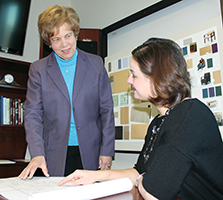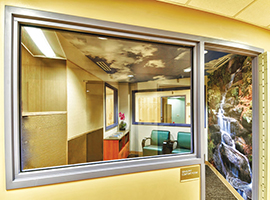By NANCY FRAZIER O'BRIEN
Halfway through the transformation of its behavioral health services, Cincinnati-based Mercy Health (formerly Catholic Health Partners) is yielding benefits in terms of patient outcomes, staff satisfaction and the bottom line.
"My mandate was to transform the delivery of mental health services" in the system's 24 hospitals in Ohio and Kentucky, said Sr. Donna Markham, OP, president of Mercy Health's Behavioral Health Institute. "We are about midway through the implementation of the transformed design, and it is progressing in a very, very positive manner.

Sr. Donna Markham, OP, left, president of Mercy Health’s Behavioral Health Institute, reviews a floor plan with Carol Parke, the institute’s chief of nursing services and operations.
"We are meeting or exceeding national benchmarks in treatment outcome measures, and there has been a 30 percent improvement in the bottom line since I began," she said.
Sr. Markham came to Mercy Health in 2012. In June she will move on to a new post as president and chief executive of Catholic Charities USA.
She credits Michael D. Connelly, president and chief executive of Mercy Health, with the initial vision for transforming behavioral health services in order to "address those left on the margins."
"We believe that if we are really going to say we are a Catholic health system, we have to deal with those most in need," she added. "And those with mental illness are in very serious need."
Attention to detail
Even though she will have left Mercy Health by then, Sr. Markham will lead an Innovation Forum during the Catholic Health Assembly, June 7-9, in Washington, D.C. The title of the June 8 session — to be conducted along with Carol Parke, chief of operations and nursing at the Behavioral Health Institute — is "A Transformational Design for Behavioral Services."
The most obvious changes are seen in the renovation of the physical space where behavioral services are delivered in Mercy Health hospitals.
Those changes have been carefully researched to provide the optimal "environment of care" for mental health services, said Navdeep S. Kang, a clinical psychologist who is director for programs excellence in the institute's Southwest Ohio market.
Several years ago, the emphasis had been on functionality rather than on "creating a calm, soothing space," he said. "There was little or no artwork on the walls, no extra emphasis on the human aspect."
"But the thinking is a bit different now," Kang added. "Every square inch is totally different."
Every paint color was researched to determine what would be the most soothing for people with emotional issues, and even the texture of furnishings was selected toward that end. The lighting "gets more intense at midday and decreases as the day progresses," Kang said, and everything is motion-activated.
Stations of recovery
Artwork on display in each renovated Mercy Health hospital includes a specially commissioned set of 10 "stations of recovery" mimicking the Stations of the Cross. Each station features a photograph paired with some brief prompts designed to help a patient think more deeply about his or her journey toward recovery, he said.

A “sensory comfort room” in the Behavioral Health Institute at Mercy Regional Medical Center in Lorain, Ohio, features warm colors and bold artwork.
The standard double-occupancy rooms have been replaced by private rooms, most with windows, and narrow corridors have been turned into "a warm, inviting, open space," Sr. Markham said.
The open-space design "is built around a healing model predicated on group interaction rather than watching TV," she added.
But changes in the delivery of behavioral health care at Mercy Health go far beyond interior design.
"The heart and soul of any program is the treatment you provide," Kang said.
Making connections
The system's mental health programs provide a continuum of care that includes acute inpatient care, partial-hospitalization programs and intensive outpatient services. In partial-hospitalization programs, patients come to the hospital during the day five days a week for behavioral health services and return home at night.
All Mercy Health clinicians participate in training sessions to ensure that best practices are being implemented, and ongoing video consultation and supervision takes place on a weekly basis. In a move that preceded the hospital renovations, staff members are connected to their counterparts throughout the system.
"Psychologists are connected to psychologists, psychiatrists to psychiatrists, charge nurses are connected and the staff in the emergency room is connected," Kang said. "There is quite a bit of cross-pollination, and it creates much more of a cohesive network."
At any Mercy Health Behavioral Health Institute, "the program model is the same, the treatment is the same," he added. "It's a pretty enormous undertaking."
But as a result, "from a staff perspective we feel much more connected within our system," Kang said. The connection with patients also is improved, as clinicians might work in an acute unit in the morning and a partial-hospitalization program in the afternoon and can "really get to see patients as they progress through care," he added.
ER and primary care outposts
"Behavioral access centers" staffed by nurses, social workers and technicians have been opened in the emergency rooms of Mercy Health hospitals to provide immediate assessment and care of mental health issues for patients who also may have coexisting medical issues.
In what is perhaps the most innovative aspect of the transformation, however, three medical practices with 13 primary care physicians in the Cincinnati area are piloting a program that places behavioral health consultants right in their offices.
If a primary care physician refers a patient to a psychiatrist or psychologist and writes a referral, "the chance that the patient will follow up on that referral is about 2 percent," Kang said. There is no "working alliance" with the behavioral health referral, and so the mental health issues might not be addressed and resolved.
"But our psych consultants work in the same hallways and examining rooms and share electronic medical records," so the primary care physician can just walk across the hall and introduce the patient to a behavioral health specialist and get an appointment set up right away, he added.
"There has been a tremendously positive reception among both patients and physicians," Kang said. "The referral rate has been much, much, much higher and we don't have those who decline" the referral.
The program, which Mercy Health plans to expand throughout the system this year, acknowledges the presumption that patients in need of behavioral health services will remain in or return to the community and to their primary care physician.
"They are not going to be with us forever," Kang said. "You have to have a great deal of collaboration to return people to their existing providers and provide a good continuum of care."
See previous coverage: Catholic Health Partners transforms behavioral health services
Copyright © 2015 by the Catholic Health Association
of the United States
For reprint permission, contact Betty Crosby or call (314) 253-3477.